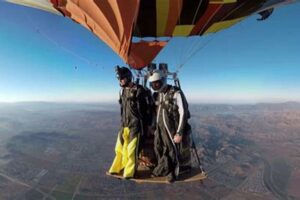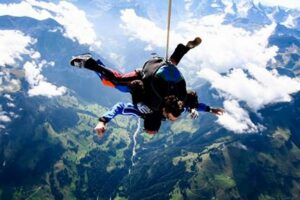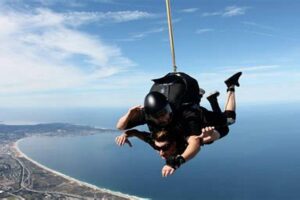Table of Contents
Skydiving Terminal Velocity: The Ultimate Rush and Peril of Freefall
Skydiving terminal velocity is the maximum speed at which a skydiver falls through the air, typically around 120 miles per hour (193 kilometers per hour). This velocity is reached when the force of gravity pulling the skydiver down is equal to the force of air resistance pushing the skydiver up. Terminal velocity is a crucial concept in skydiving, as it determines the time a skydiver has to deploy their parachute safely.
Understanding terminal velocity is essential for skydivers to calculate their fall time and ensure they have enough altitude to deploy their parachute. It also plays a role in determining the type of parachute and deployment method a skydiver should use. Historically, the development of specialized parachutes and training techniques has significantly improved skydivers’ ability to control their descent and reduce the risk of injury or death.
In this article, we will delve deeper into the physics and factors influencing terminal velocity in skydiving, explore the techniques skydivers use to control their fall, and discuss the safety considerations and advancements that have shaped the sport.
Skydiving Terminal Velocity
Understanding the essential aspects of skydiving terminal velocity is crucial for ensuring safety and maximizing the thrill of freefall.
- Definition: Maximum speed of a skydiver in freefall.
- Factors: Body position, weight, and air resistance.
- Calculation: Force of gravity equals air resistance.
- Range: Typically 120-150 miles per hour (193-241 kilometers per hour).
- Control: Body position and specialized equipment.
- Safety: Parachute deployment altitude and timing.
- Records: Felix Baumgartner’s supersonic freefall in 2012.
- Advancements: Improved parachutes and training techniques.
These aspects are interconnected and influence the overall skydiving experience. For instance, a skydiver’s body position can affect their terminal velocity, which in turn impacts the time available for parachute deployment. Safety protocols and advancements in equipment have significantly reduced the risks associated with skydiving, making it a more accessible and exhilarating sport.
Definition
The definition of skydiving terminal velocity as the maximum speed of a skydiver in freefall is a crucial concept in the sport, with significant implications for safety and the overall skydiving experience.
Cause and Effect: Terminal velocity is the result of the interaction between gravity and air resistance. As a skydiver falls, gravity pulls them towards the earth, causing them to accelerate. However, as their speed increases, air resistance also increases, eventually reaching a point where it equals the force of gravity. At this point, the skydiver reaches terminal velocity and their speed stabilizes.
Critical Component: Understanding terminal velocity is essential for skydivers to calculate their fall time and ensure they have enough altitude to deploy their parachute safely. Terminal velocity also determines the type of parachute and deployment method a skydiver should use.
Real-Life Examples: Terminal velocity plays a vital role in various skydiving disciplines. In skydiving competitions, skydivers aim to achieve a high terminal velocity during freefall to gain an advantage in speed and distance. BASE jumpers, who jump from fixed objects like cliffs or buildings, need to consider terminal velocity when calculating their jump altitude and trajectory.
Practical Applications: The understanding of terminal velocity has practical applications beyond skydiving. It is used in the design of parachutes, aircraft emergency escape systems, and even wind turbines. By understanding the factors that affect terminal velocity, engineers can optimize the performance of these systems.
Conclusion: The definition of skydiving terminal velocity as the maximum speed of a skydiver in freefall is a cornerstone concept in the sport, influencing safety, performance, and equipment design. It underscores the intricate interplay between gravity, air resistance, and human skill, making skydiving an exhilarating and challenging activity.
Factors
The relationship between body position, weight, and air resistance is a critical component of understanding skydiving terminal velocity. These factors interact to determine the maximum speed a skydiver can achieve during freefall.
Cause and Effect:
- Body Position: The orientation of the skydiver’s body affects the surface area exposed to air resistance. A streamlined position, with the body aligned parallel to the direction of motion, reduces air resistance and allows for a higher terminal velocity.
- Weight: A heavier skydiver experiences greater force from gravity, resulting in a higher terminal velocity. This is because weight is a measure of the force of gravity acting on an object.
- Air Resistance: As a skydiver falls, air resistance increases due to the interaction between the skydiver’s body and the air molecules. This resistance acts in the opposite direction of motion, slowing down the skydiver and eventually leading to terminal velocity.
Real-Life Examples:
- Body Position: In competitive skydiving, skydivers adopt a streamlined body position called the “pencil” or “stream” position to minimize air resistance and achieve a higher terminal velocity.
- Weight: Heavier skydivers may reach a higher terminal velocity than lighter skydivers due to the increased force of gravity acting on them.
- Air Resistance: Skydivers use specialized jumpsuits and equipment to increase air resistance and control their terminal velocity. For example, BASE jumpers may wear a wingsuit to increase their surface area and generate more air resistance.
Practical Applications:
- Parachute Deployment: Understanding terminal velocity is crucial for determining the appropriate altitude for parachute deployment. Skydivers must deploy their parachutes before reaching a dangerously high terminal velocity that could lead to injury or death.
- Equipment Design: The design of skydiving equipment, such as parachutes, jumpsuits, and helmets, considers the factors of body position, weight, and air resistance to optimize performance and safety.
- Training and Techniques: Skydivers receive extensive training on body position, weight distribution, and air resistance control to help them achieve a stable and controlled terminal velocity during freefall.
Conclusion:The factors of body position, weight, and air resistance play a critical role in determining skydiving terminal velocity. By understanding and manipulating these factors, skydivers can control their descent, optimize their performance, and enhance their overall safety. These insights also have practical applications in the design of skydiving equipment and training protocols.
Calculation
The equation “Force of gravity equals air resistance” encapsulates the fundamental principle governing skydiving terminal velocity. This relationship underpins the understanding of how sky
divers achieve a stable descent rate during freefall.
Cause and Effect:Gravity, an omnipresent force, pulls skydivers towards the earth, causing them to accelerate as they fall. Simultaneously, air resistance, a force that opposes motion through the air, acts against the skydiver’s descent. As the skydiver’s speed increases, so does air resistance. At a certain point, air resistance becomes equal to the force of gravity, resulting in a constant velocity known as terminal velocity.
Critical Component:The calculation of force of gravity equals air resistance is a critical component of skydiving terminal velocity because it determines the maximum speed at which a skydiver can fall. This understanding is crucial for ensuring safety during skydiving, as it allows skydivers to calculate their fall time and determine the appropriate altitude for parachute deployment.
Real-Life Examples:In skydiving competitions, participants aim to achieve a high terminal velocity during freefall to gain an advantage in speed and distance events. To achieve this, they adopt a streamlined body position to minimize air resistance and maximize their speed. Conversely, BASE jumpers, who jump from fixed objects like cliffs or buildings, need to consider terminal velocity when calculating their jump altitude and trajectory to avoid exceeding safe limits.
Practical Applications:Understanding the relationship between force of gravity and air resistance has practical applications beyond skydiving. It is used in the design of parachutes, aircraft emergency escape systems, and even wind turbines. By manipulating the factors that affect air resistance, engineers can optimize the performance and safety of these systems.
Conclusion:The calculation “Force of gravity equals air resistance” provides a fundamental framework for comprehending skydiving terminal velocity. This relationship dictates the maximum speed at which a skydiver can fall, influencing safety protocols, competitive strategies, and equipment design. Its broader applications extend to various fields, underscoring the significance of understanding the interplay between gravity, air resistance, and human skill in achieving controlled descent.
Range
The range of skydiving terminal velocity, typically falling between 120 and 150 miles per hour (193 to 241 kilometers per hour), is a crucial aspect of the sport, deeply intertwined with the physics of freefall.
Cause and Effect: Terminal velocity is the maximum speed at which a skydiver falls through the air, achieved when the force of gravity pulling the skydiver down is equal to the force of air resistance pushing the skydiver up. The range of terminal velocity is primarily determined by the skydiver’s body position, weight, and air resistance. A streamlined body position, heavier weight, and increased air resistance all contribute to a higher terminal velocity.
Critical Component: Understanding the range of terminal velocity is critical for skydivers to calculate their fall time and ensure they have sufficient altitude to deploy their parachute safely. Additionally, the range of terminal velocity influences the type of parachute and deployment method a skydiver should use.
Real-Life Examples: In competitive skydiving disciplines, such as speed skydiving, participants aim to achieve a higher terminal velocity during freefall to gain an advantage. They adopt streamlined body positions and wear specialized suits to minimize air resistance and maximize their speed. On the other hand, BASE jumpers, who jump from fixed objects like cliffs or buildings, need to consider the range of terminal velocity when calculating their jump altitude and trajectory to avoid exceeding safe limits.
Practical Applications: Beyond skydiving, the understanding of terminal velocity has practical applications in various fields. In the design of parachutes, engineers consider the range of terminal velocity to ensure that parachutes can safely slow down skydivers from their maximum speed. Additionally, terminal velocity is a factor in the design of aircraft emergency escape systems and wind turbines.
Conclusion: The range of skydiving terminal velocity is a critical aspect of the sport, influencing safety protocols, competitive strategies, and equipment design. Understanding the factors that affect terminal velocity and its range is essential for skydivers to make informed decisions and ensure a safe and enjoyable skydiving experience.
Control
In the realm of skydiving, achieving precise control over terminal velocity is paramount for ensuring safety and enhancing performance. This control is primarily exerted through body position and the strategic use of specialized equipment.
Cause and Effect: The skydiver’s body position plays a crucial role in determining terminal velocity. A streamlined body position, with the body aligned parallel to the direction of motion, minimizes air resistance, allowing for a higher terminal velocity. Conversely, a spread-eagle position increases air resistance, resulting in a lower terminal velocity. Specialized equipment, such as wingsuits and drogue parachutes, can further modify air resistance and, consequently, terminal velocity.
Critical Component: Control over body position and specialized equipment is a critical component of skydiving terminal velocity. By manipulating these factors, skydivers can influence their speed of descent, optimize their freefall experience, and enhance their overall safety. This control enables skydivers to maintain stable and controlled flight, execute intricate maneuvers, and accurately navigate through the air.
Real-Life Examples: In competitive skydiving disciplines, such as speed skydiving and freeflying, precise control over body position and specialized equipment is essential for achieving peak performance. Skydivers adopt aerodynamic body positions and utilize specialized suits to minimize air resistance and attain maximum speed. Conversely, BASE jumpers, who leap from fixed objects like cliffs or buildings, rely on wingsuits to increase air resistance and control their descent, allowing for safe landings in confined areas.
Practical Applications: The understanding of the relationship between control, body position, specialized equipment, and terminal velocity has practical applications beyond skydiving. In the design of parachutes, engineers consider the impact of body position and specialized equipment on terminal velocity to ensure that parachutes can effectively slow down skydivers from their maximum speed. Additionally, this understanding is crucial in the development of aircraft emergency escape systems and wind turbines.
Conclusion: Control over body position and specialized equipment is a fundamental aspect of skydiving terminal velocity, influencing safety, performance, and the overall skydiving experience. By understanding and manipulating these factors, skydivers can achieve precise control over their descent, execute intricate maneuvers, and navigate through the air with skill and precision. This understanding has broader applications in the design of parachutes, aircraft emergency escape systems, and wind turbines, demonstrating the interdisciplinary nature of skydiving science and engineering.
Safety
Within the realm of skydiving, ensuring the safety of participants is paramount. One critical aspect of this is understanding and adhering to proper parachute deployment altitude and timing. This involves calculating the optimal altitude at which a skydiver should deploy their parachute, considering factors such as terminal velocity, air resistance, and the type of parachute being used.
- Deployment Altitude: The altitude at which a skydiver deploys their parachute is crucial for ensuring a safe and controlled descent. Factors such as terminal velocity, air resistanc
e, and the type of parachute determine the appropriate deployment altitude. - Reserve Parachute: Skydivers typically carry a reserve parachute as a backup in case of malfunctions with the main parachute. Knowing when and how to deploy the reserve parachute is essential for emergency situations.
- Wind Conditions: Wind speed and direction can significantly affect the deployment and descent of a parachute. Skydivers must consider these conditions when determining their deployment altitude and trajectory.
- Training and Experience: Proper training and experience are vital for skydivers to make sound decisions regarding parachute deployment altitude and timing. Understanding the physics of freefall and the operation of parachutes is crucial for ensuring safety.
In conclusion, parachute deployment altitude and timing play a pivotal role in ensuring the safety of skydivers. By carefully calculating the appropriate deployment altitude, considering factors like terminal velocity and wind conditions, and undergoing thorough training, skydivers can mitigate risks and enhance their overall safety during freefall.
Records
Felix Baumgartner’s record-breaking supersonic freefall in 2012 stands as a remarkable milestone in the history of skydiving and human achievement. His daring feat not only pushed the boundaries of human endurance but also provided valuable insights into the realm of skydiving terminal velocity.
Baumgartner’s freefall from a helium balloon 24 miles above Earth’s surface allowed him to experience a state known as terminal velocity, the maximum speed at which an object falls through a fluid (in this case, air). As he plummeted towards the ground, his body reached a terminal velocity of approximately 834 miles per hour (1,342 kilometers per hour), surpassing the speed of sound and making him the first human to achieve supersonic freefall.
This historic event serves as a critical component in understanding skydiving terminal velocity. Baumgartner’s freefall provided real-life data and observations that contributed to a deeper comprehension of the factors influencing terminal velocity, such as body position, air resistance, and gravitational forces. It also highlighted the importance of meticulous planning, specialized equipment, and rigorous training in ensuring the safety and success of high-altitude skydiving endeavors.
The practical applications of the knowledge gained from Baumgartner’s supersonic freefall extend beyond the realm of skydiving. The study of terminal velocity and the associated forces has implications for the design and development of parachutes, aircraft emergency escape systems, and spacecraft re-entry vehicles. Additionally, the understanding of terminal velocity is crucial for military applications, such as high-altitude military operations and the development of precision-guided munitions.
In conclusion, Felix Baumgartner’s supersonic freefall in 2012 not only captured the world’s attention but also yielded significant insights into the realm of skydiving terminal velocity. This historic event serves as a testament to human ingenuity, pushing the limits of what is possible while simultaneously contributing to the advancement of scientific knowledge and practical applications.
Advancements
The evolution of skydiving has been significantly influenced by advancements in parachute technology and training techniques. These advancements have played a pivotal role in shaping the landscape of the sport, enhancing safety, and enabling skydivers to push the boundaries of human flight.
Cause and Effect: Improved parachutes and training techniques have a direct impact on skydiving terminal velocity. Advances in parachute design, such as the development of high-performance canopies and sophisticated deployment systems, have enabled skydivers to achieve greater control over their descent and reduce their terminal velocity. Additionally, enhanced training methods have equipped skydivers with the skills and knowledge necessary to make informed decisions and execute safe and controlled landings.
Critical Component: Advancements in parachutes and training techniques are critical components of skydiving terminal velocity. By mitigating the risks associated with high-speed descents, these advancements have made skydiving more accessible and enjoyable for participants of all skill levels. The ability to control terminal velocity has also opened up new possibilities for competitive skydiving disciplines, such as speed skydiving and freeflying, where precise maneuvering and controlled descents are essential.
Real-Life Examples: The connection between advancements in parachutes and training techniques and skydiving terminal velocity is evident in several real-life examples. The development of ram-air parachutes, which are steerable and allow for precise landings, has revolutionized the sport. These parachutes have significantly improved safety by enabling skydivers to avoid obstacles and land accurately in designated drop zones. Additionally, the introduction of training programs and certification requirements has standardized skydiving instruction and ensured that participants receive comprehensive training before attempting solo jumps.
Practical Applications: The understanding gained from advancements in parachutes and training techniques has practical applications beyond the realm of skydiving. The study of terminal velocity and the development of high-performance parachutes have contributed to the design of emergency escape systems for aircraft and spacecraft. The principles of controlled descent have also been applied to the development of military parachutes and precision-guided munitions. Furthermore, the training methods and safety protocols established in skydiving have served as a model for other adventure sports and high-risk activities.
Conclusion: Advancements in parachutes and training techniques have transformed skydiving, making it safer, more accessible, and more exhilarating. These advancements have played a crucial role in influencing skydiving terminal velocity, enabling skydivers to control their descents and push the limits of the sport. The insights gained from these advancements have also had broader implications, contributing to the development of life-saving technologies and enhancing safety in various fields.
Frequently Asked Questions about Skydiving Terminal Velocity
This section addresses common questions and misconceptions surrounding skydiving terminal velocity, providing concise and informative answers to enhance your understanding of this crucial aspect of the sport.
Question 1: What is skydiving terminal velocity?
Skydiving terminal velocity refers to the maximum speed at which a skydiver falls through the air, typically around 120-150 miles per hour (193-241 kilometers per hour). This velocity is reached when the force of gravity pulling the skydiver down is equal to the force of air resistance pushing the skydiver up.
Question 2: What factors influence terminal velocity in skydiving?
Terminal velocity in skydiving is primarily determined by body position, weight, and air resistance. A streamlined body position, heavier weight, and increased air resistance all contribute to a higher terminal velocity.
Question 3: How do skydivers control their terminal velocity?
Skydivers can control their terminal velocity by adjusting their body position and using specialized equipment. By adopting a streamlined body position and deploying drogue parachutes or wingsuits, skydivers can increase air resistance and reduce their terminal velocity.
Question 4: What is the importance of understanding terminal velocity in skydiving?
Understanding terminal velocity is crucial for skydivers to calculate their fall time and en
sure they have sufficient altitude to deploy their parachute safely. It also influences the type of parachute and deployment method a skydiver should use.
Question 5: What was Felix Baumgartner’s contribution to the understanding of terminal velocity?
Felix Baumgartner’s record-breaking supersonic freefall in 2012 provided valuable insights into skydiving terminal velocity. His descent allowed researchers to study the effects of high-speed freefall on the human body and contributed to a deeper understanding of the factors influencing terminal velocity.
Question 6: How have advancements in skydiving technology impacted terminal velocity?
Advancements in skydiving technology, such as improved parachute designs and training techniques, have significantly influenced terminal velocity. High-performance parachutes and sophisticated deployment systems have enabled skydivers to achieve greater control over their descent and reduce their terminal velocity, enhancing safety and expanding the possibilities for competitive skydiving.
In summary, understanding skydiving terminal velocity is essential for ensuring safety, optimizing performance, and pushing the boundaries of the sport. By manipulating factors such as body position, weight, air resistance, and specialized equipment, skydivers can control their descent and achieve precise maneuvering. These insights into terminal velocity have practical applications beyond skydiving, contributing to the design of parachutes, aircraft emergency escape systems, and even wind turbines.
In the next section, we will delve deeper into the physics of skydiving terminal velocity, exploring the intricate relationship between gravity, air resistance, and human skill, and how these elements combine to create the exhilarating experience of freefall.
TIPS FOR UNDERSTANDING SKYDIVING TERMINAL VELOCITY
This section provides practical tips to help you grasp the concept of skydiving terminal velocity and its significance in the sport.
Tip 1: Visualize the Forces: Imagine yourself in freefall, with gravity pulling you down and air resistance pushing you up. The point at which these forces balance is your terminal velocity.
Tip 2: Experiment with Body Position: In a wind tunnel or skydiving simulator, try different body positions to experience how they affect your speed. A streamlined position reduces air resistance and increases terminal velocity.
Tip 3: Consider Your Weight: Heavier skydivers generally have a higher terminal velocity due to the increased force of gravity acting on them.
Tip 4: Understand Air Resistance: Air resistance is a crucial factor in determining terminal velocity. Specialized equipment like wingsuits and drogue parachutes increase air resistance, reducing your terminal velocity.
Tip 5: Practice Precision: Work on controlling your body position and adjusting your equipment to achieve precise control over your descent. This is especially important for competitive skydiving disciplines.
Tip 6: Seek Professional Training: Enroll in a skydiving training program to learn the necessary skills and techniques for safe and controlled freefall. Proper training helps you understand terminal velocity and make informed decisions during your jumps.
Tip 7: Stay Informed about Advancements: Keep up with the latest developments in skydiving technology, such as parachute designs and training methods. These advancements contribute to safer and more enjoyable skydiving experiences.
Tip 8: Respect the Risks: While skydiving is a thrilling sport, it also carries inherent risks. Always prioritize safety by adhering to proper procedures, using high-quality equipment, and seeking continuous training.
By following these tips, you can gain a deeper understanding of skydiving terminal velocity, appreciate its significance, and enhance your overall skydiving experience.
In the concluding section, we will explore the broader implications of terminal velocity in skydiving, examining how it influences safety protocols, competitive strategies, and equipment design, and highlighting its relevance beyond the realm of skydiving.
Conclusion
Our exploration of skydiving terminal velocity has illuminated several key ideas and findings. Firstly, terminal velocity is a crucial concept in skydiving, influencing safety, performance, and equipment design. Secondly, factors such as body position, weight, and air resistance play a critical role in determining a skydiver’s terminal velocity. Thirdly, advancements in parachute technology and training techniques have significantly enhanced skydivers’ control over their descent and increased safety.
These main points are interconnected. Understanding the factors affecting terminal velocity allows skydivers to calculate their fall time and ensure safe parachute deployment. Advancements in equipment and training empower skydivers to manipulate these factors, enabling precise control during freefall. The interplay between these elements creates a dynamic and exhilarating experience for skydivers.
In conclusion, skydiving terminal velocity is a captivating topic that encompasses physics, engineering, and human skill. As skydiving continues to evolve, the pursuit of understanding and controlling terminal velocity will remain at the forefront of the sport, driving innovation and pushing the boundaries of human flight.







